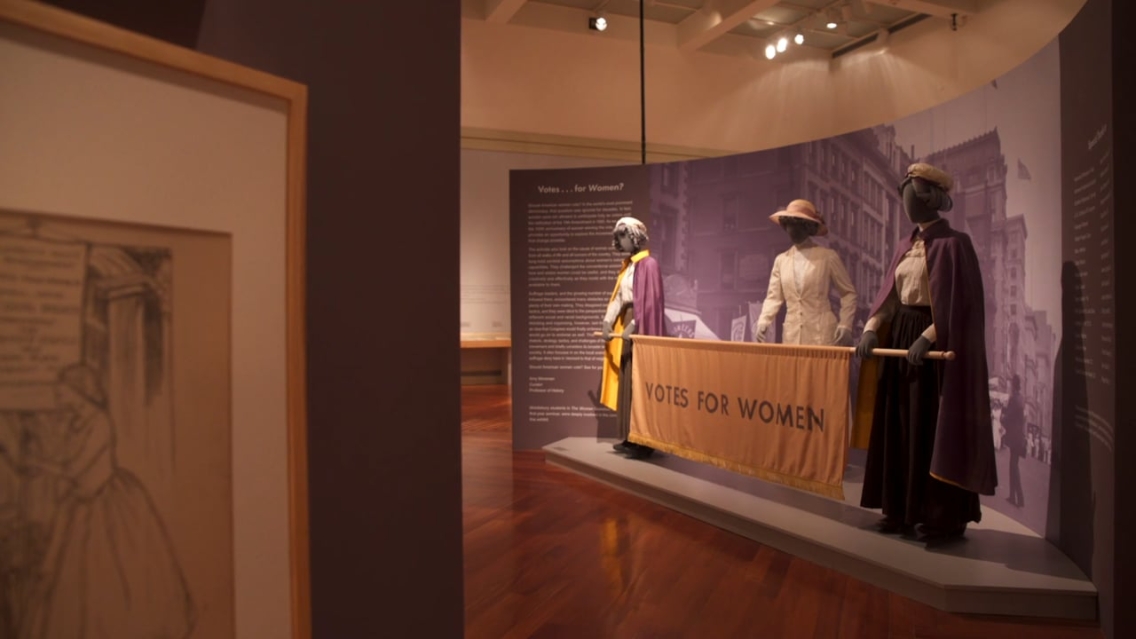Lessons from the Suffrage Movement 100 Years after the 19th Amendment
MIDDLEBURY, Vt. – A new exhibition at the Middlebury College Museum of Art marks the centennial of the 19th Amendment, which granted women the right to vote. Filled with historic photos, banners, and memorabilia, Votes for … Women? documents the protracted struggle of the suffrage movement, and its uneven legacy for American women in the decades that followed ratification.
“What strikes me about voting rights today and the connection to suffrage is that unity really matters, but unity is very hard to attain,” said Professor of History Amy Morsman, who curated the exhibit. “The suffrage story shows, time and time again, that it will take a very long time to get something done if you don’t present a unified front.”
Two years ago, museum director Richard Saunders was thinking about the upcoming centennial of the 19th Amendment and wondered if there were a way to honor the anniversary with an exhibition. As he often does, Saunders enlisted the help of a faculty member—in this case, Morsman—as a way of engaging students with the museum and providing an experiential component to their class.
Morsman, who teaches courses on women’s history, thought the exhibit could make a good focal point for her first-year seminar, titled The Woman Question: Pondering Women’s Place in a Changing Society. It was her first experience curating a museum exhibit, but she dove in with Saunders’s encouragement.
“I think, for my students, it was helpful for them to see me as someone who hadn’t done this before,” says Morsman. “I was learning with them.”
In addition to their regular course work, the students met with the College’s museum designer, Ken Pohlman, to learn about how people experience exhibit spaces—literally, the paths they’re likely to take as they walk through a particular space. They learned about the many kinds of materials used to build an exhibit as well as how to use space effectively.
“We had multiple discussions on thinking about history and learning about history, but then we tackled the challenge of how to relay this history to the public and raise awareness about important issues within the constraints of a small physical space,” said Morsman.
Morsman said her students were very helpful in identifying aspects of the suffrage movement that might be of interest to the public. “If my students were interested in this issue or that controversy, that was telling me that it would be a good thing for me to remember once my first-year seminar had ended and the other work of exhibit building began,” she said.
Saunders and Morsman, meanwhile, collected vintage photographs, banners, costumes, and memorabilia from a variety of sources, including from the major photography collector George Rinhart. They worked with the College’s Oratory Now project to record important speeches of the time period, as performed by students, which visitors can listen to in the gallery.
The exhibition is arranged by theme rather than chronologically. The first three sections explore arguments for and against suffrage, strategies developed by the movement’s leaders, and the tactics they used to reach their goals.
The second half of the exhibit looks at the divisions and conflicts within the movement, as well as its legacy.
“Suffrage was a victory in 1919 and 1920, but it was incomplete,” said Morsman. “There were plenty of women who could not vote for decades. There may be plenty of women now who can’t vote for one reason or another. There were all kinds of controversies and conflicts that divided women after 1920 as well as before, and the exhibit touches on that point.”
While primarily focused on the national movement, the exhibit also offers a window into what was happening locally in Vermont and neighboring New York.
Saunders says the exhibition’s title, Votes … for Women?, plays on what has become a standard way of describing the 19th Amendment: “Votes for Women.” Turning it into a question was Morsman’s idea, a way to emphasize that, for many people, it was a real and challenging question. The provocative title also reminds visitors how much they may take for granted.
“I want people to know that women getting the right to vote was not a foregone conclusion,” said Morsman. “It took a very long time. It took convincing women as well as men. This was not an obvious thing for women in the 1840s, in the 1880s, in the nineteen-teens, to say, ‘This is not only my right; this is my responsibility.’”
Votes … for Women? will be on display at the Middlebury College Museum of Art through December 8, 2019.
By Stephen Diehl; Photo by Paul Dahm for Middlebury Magazine


